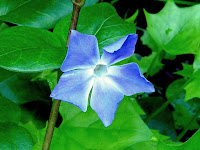Laver or lava bread is a Welsh delicacy made from seaweed. It grows on the rocks along the Gower Coast and the West coast of Wales and Southern island. It grows flat on rocks with long trailing fronds in the sea water. The Japanese love it and it is used in sushi, but they have it dried and flattened into sheets, and in this form it is called nori.
In Wales it is sold already boiled in Swansea market, along with cockles and elvers (baby eels) which tend to crawl all over the fish and the laver bread. I used to get it either there or in a small fish mongers in Oystermouth (also known as Mumbles).
 It is first mentioned as food in 1607 in Camden’s Britannica, and it says that it (lhawvan) came from Pembrokeshire and Pembroke. Later the author and traveler, George Borrow- famous for “The Romany Rye” and “Lavengro”, wrote about it in his book “Wild Wales” published in 1862. He ate “moor mutton and piping hot laver sauce.” A famous Welshman called it “The Welshman’s caviar” which is certainly stretching a point, and although elsewhere on the Net this is attributed to the Welsh actor, Richard Burton, it sounds more like the kind of quip the Welsh poet Dylan Thomas would have made. After all, Dylan Thomas was born and grew up in Swansea, and in later life lived at Laugharne, also on the Gower Coast. Some people tend to confuse the poet and the actor because Richard Burton famously did a recording of Dylan Thomas’ play “Under Milk Wood”.
It is first mentioned as food in 1607 in Camden’s Britannica, and it says that it (lhawvan) came from Pembrokeshire and Pembroke. Later the author and traveler, George Borrow- famous for “The Romany Rye” and “Lavengro”, wrote about it in his book “Wild Wales” published in 1862. He ate “moor mutton and piping hot laver sauce.” A famous Welshman called it “The Welshman’s caviar” which is certainly stretching a point, and although elsewhere on the Net this is attributed to the Welsh actor, Richard Burton, it sounds more like the kind of quip the Welsh poet Dylan Thomas would have made. After all, Dylan Thomas was born and grew up in Swansea, and in later life lived at Laugharne, also on the Gower Coast. Some people tend to confuse the poet and the actor because Richard Burton famously did a recording of Dylan Thomas’ play “Under Milk Wood”. Laverbread or bara lawr as it is named in Welsh, is exceptionally good for health as it contains iron and iodine along with around 50 known other minerals. It also has vitamins A, C and D as well as some of the B-complex ones.
To cook it from scratch having collected it from the rocks, it has to be plunged in boiling water and boiled for about 40 minutes, or until it starts to break down. Traditionally it was served with cockles (chocos in Welsh- interestingly that is cuttlefish in Portuguese) and sausages, bacon and eggs as a hearty breakfast for Welsh miners. Mushrooms and black pudding may also have been served with it. It is traditional to cook it mixed with oatmeal in bacon fat, but olive oil is a good substitute, and much healthier.
Laverbread could help in the aftermath of a nuclear explosion, as it contains a compound which binds with heavy metals in the gastro-intestinal tract to form a gel-like salt which is believed to remove radio-active particles from the gut. It can help keep joints supple, and gives those that eat it a glowing healthy complexion.
It contains a chemical that has been named M26 which could be useful in the future, when more research has been done into it, to help combat AIDS. A Japanese study has shown that it successful in fighting flu as it boosts the immune system.
It can be healthy as long as it isn’t cooked in fat. Use olive oil instead. You can add the boiled laver bread to soups and sauces, risotto, stuffings and you can find it in a few Welsh cheeses. You can eat it as it comes from a fish stall served with toast and lemon wedges and a little poached shredded leek.
Ingredients
400 gr laver
60 gr butter or olive oil
60 ml orange juice
salt and freshly ground black pepper to taste
Method
Plunge the seaweed into boiling water and cook for about 40 minutes until it starts to break up.
Drain and wrap in an absorbent tea towel to get rid of the excess water.
Heat the butter in a pan and add the seaweed and fry for 8-10 minutes.
Add the orange juice and allow this to heat through.
Add seasoning and serve with roast lamb.
This has Taste and is a Treat.


























